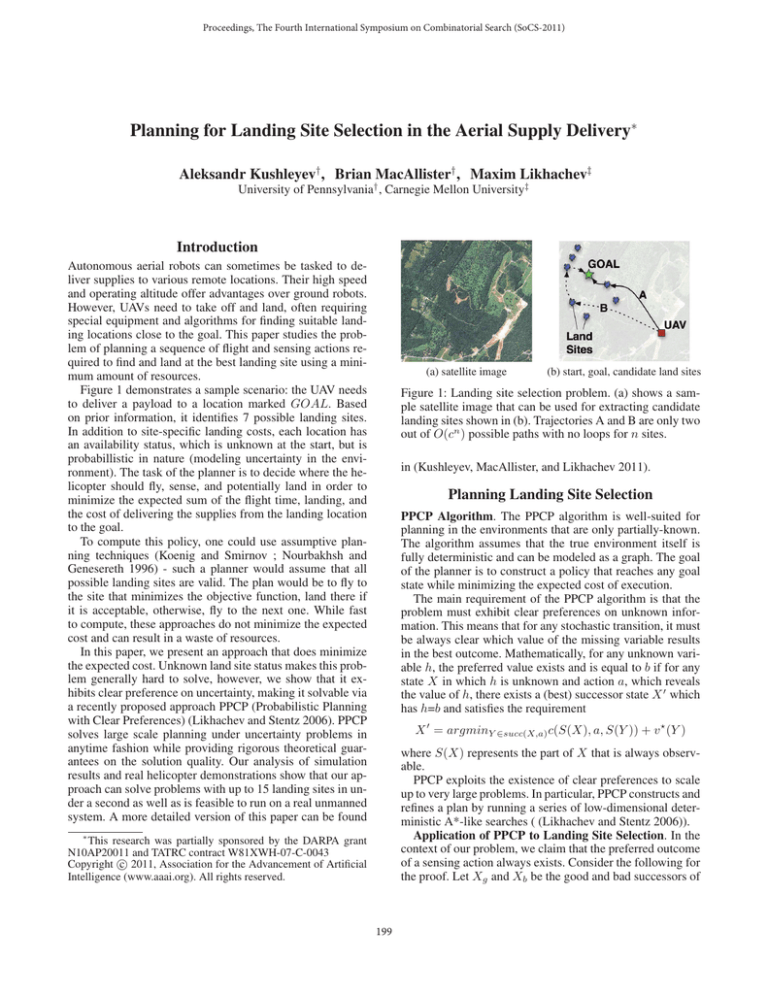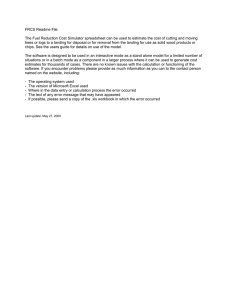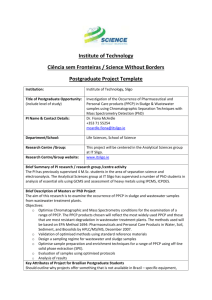
Proceedings, The Fourth International Symposium on Combinatorial Search (SoCS-2011)
Planning for Landing Site Selection in the Aerial Supply Delivery∗
Aleksandr Kushleyev† , Brian MacAllister† , Maxim Likhachev‡
University of Pennsylvania† , Carnegie Mellon University‡
Introduction
Autonomous aerial robots can sometimes be tasked to deliver supplies to various remote locations. Their high speed
and operating altitude offer advantages over ground robots.
However, UAVs need to take off and land, often requiring
special equipment and algorithms for finding suitable landing locations close to the goal. This paper studies the problem of planning a sequence of flight and sensing actions required to find and land at the best landing site using a minimum amount of resources.
Figure 1 demonstrates a sample scenario: the UAV needs
to deliver a payload to a location marked GOAL. Based
on prior information, it identifies 7 possible landing sites.
In addition to site-specific landing costs, each location has
an availability status, which is unknown at the start, but is
probabillistic in nature (modeling uncertainty in the environment). The task of the planner is to decide where the helicopter should fly, sense, and potentially land in order to
minimize the expected sum of the flight time, landing, and
the cost of delivering the supplies from the landing location
to the goal.
To compute this policy, one could use assumptive planning techniques (Koenig and Smirnov ; Nourbakhsh and
Genesereth 1996) - such a planner would assume that all
possible landing sites are valid. The plan would be to fly to
the site that minimizes the objective function, land there if
it is acceptable, otherwise, fly to the next one. While fast
to compute, these approaches do not minimize the expected
cost and can result in a waste of resources.
In this paper, we present an approach that does minimize
the expected cost. Unknown land site status makes this problem generally hard to solve, however, we show that it exhibits clear preference on uncertainty, making it solvable via
a recently proposed approach PPCP (Probabilistic Planning
with Clear Preferences) (Likhachev and Stentz 2006). PPCP
solves large scale planning under uncertainty problems in
anytime fashion while providing rigorous theoretical guarantees on the solution quality. Our analysis of simulation
results and real helicopter demonstrations show that our approach can solve problems with up to 15 landing sites in under a second as well as is feasible to run on a real unmanned
system. A more detailed version of this paper can be found
(a) satellite image
(b) start, goal, candidate land sites
Figure 1: Landing site selection problem. (a) shows a sample satellite image that can be used for extracting candidate
landing sites shown in (b). Trajectories A and B are only two
out of O(cn ) possible paths with no loops for n sites.
in (Kushleyev, MacAllister, and Likhachev 2011).
Planning Landing Site Selection
PPCP Algorithm. The PPCP algorithm is well-suited for
planning in the environments that are only partially-known.
The algorithm assumes that the true environment itself is
fully deterministic and can be modeled as a graph. The goal
of the planner is to construct a policy that reaches any goal
state while minimizing the expected cost of execution.
The main requirement of the PPCP algorithm is that the
problem must exhibit clear preferences on unknown information. This means that for any stochastic transition, it must
be always clear which value of the missing variable results
in the best outcome. Mathematically, for any unknown variable h, the preferred value exists and is equal to b if for any
state X in which h is unknown and action a, which reveals
the value of h, there exists a (best) successor state X which
has h=b and satisfies the requirement
X = argminY ∈succ(X,a) c(S(X), a, S(Y )) + v (Y )
where S(X) represents the part of X that is always observable.
PPCP exploits the existence of clear preferences to scale
up to very large problems. In particular, PPCP constructs and
refines a plan by running a series of low-dimensional deterministic A*-like searches ( (Likhachev and Stentz 2006)).
Application of PPCP to Landing Site Selection. In the
context of our problem, we claim that the preferred outcome
of a sensing action always exists. Consider the following for
the proof. Let Xg and Xb be the good and bad successors of
∗
This research was partially sponsored by the DARPA grant
N10AP20011 and TATRC contract W81XWH-07-C-0043
c 2011, Association for the Advancement of Artificial
Copyright Intelligence (www.aaai.org). All rights reserved.
199
(a) 3D map, landsites, PPCP policy
(b) Ready to take off
(c) Sensing Site1
(d) Sensing Site1 (map)
(e) Landing at Site2
Figure 2: 3D map and stills from an autonomous run
any state Y after performing a sensing action. Let v (Xb ) be
the cost of executing the optimal policy at Xb . Similarly, we
define v (Xg ) for Xg . Also, let A(Xb ) and A(Xg ) be the
sets of possible further actions at the corresponding states.
According to our formulation, A(Xg ) = {A(Xb ), land}.
This is true since if the outcome of sensing action is good,
the further action set is augmented by the ability to land.
Therefore, the robot at Xg still has an option of following
Xb ’s optimal policy and v (Xg ) ≤ v (Xb ), making Xg the
preferred outcome. This is a consequence of the fact that
knowing that a landing site is good does not invalidate Xb ’s
(or, in fact, any other state’s) optimal policy.
The PPCP algorithm exhibits memoryless property - it
does not remember the preferred outcomes of stochastic actions. This enables it to efficiently solve large-scale problems with uncertainty without traversing the whole belief
state space, however the solution may be suboptimal if the
true optimal policy relies on remembering preferred outcomes. We can never know whether the optimal policy requires memory, but our implementation allows to vary the
number of remembered preferred outcomes (memory slots),
trading off with execution speed.
Theoretical Properties. The expected cost of the PPCP
policy after full convergence, is upper-bounded by the optimal policy found by any memoryless planner, assuming that
PPCP assumptions hold. This means that while being very
efficient, our planner cannot be beaten (cost-wise) by any
memoryless planner. If one or more memory slots are used
in the PPCP algorithm, the guarantees are even better. For
k memory slots, the upper bound drops to the optimal policy found by any planner that can remember the last k good
landing sites. Formally, our planner provides the following
guarantee on the quality of solution:
Number of
sites
5
10
15
0 mem slot
(msec)
0.6± 0.3
32± 36
560± 1000
1 mem slot
(msec)
1.7± 0.9
205± 290
15000± 11000
Belief state
space size
4.1 × 103
1.9 × 106
6.7 × 108
Figure 3: Average planning times for memoryless PPCP and
with one memory slot. The size of the full belief state space
is given for reference - PPCP planner finds the solution by
computing a tiny fraction of this space.
# PPCP (expected)
1839.05
PPCP (actual)
1839.16
Assumptive Planner
1947.25
Figure 4: Summary of the results over 2500 runs with 10
landing sites, comparing the expected cost of the PPCP policy, actual cost of traversing PPCP policy, and actual cost of
following an assumptive planner
domly generated site probabilities and computing actual execution costs of both policies. Figure 4 shows the results
after running 2500 planning scenarios. PPCP policies were
consistently better in execution by about 5%.
In addition, we have tested the planner on a real quadrotor platform, equipped with a dual core processor and
LIDAR sensors, shown in Figure 2(b). All the processing
was performed on-board : perception, landing planning, motion planning and low-level control. Planning for four landing sites took 0.2 msec. Figure 2(a) shows the planned policy
and Figure 2(b-e) presents still photographs from the fully
autonomous flight according to the policy.
References
Koenig, S., and Smirnov, Y. Sensor-based planning with the
freespace assumption. In Proceedings of the IEEE International Conference on Robotics and Automation (ICRA).
Kushleyev, A.; MacAllister, B.; and Likhachev, M. 2011.
Planning for landing site selection in the aerial supply delivery. In Proceedings of the IEEE/RSJ International Conference on Intelligent Robots and Systems (IROS).
Likhachev, M., and Stentz, A. 2006. PPCP: Efficient probabilistic planning with clear preferences in partially-known
environments. In Proceedings of the National Conference
on Artificial Intelligence (AAAI).
Nourbakhsh, I., and Genesereth, M. 1996. Assumptive planning and execution: a simple, working robot architecture.
Autonomous Robots Journal 3(1):49–67.
Theorem 1 The policy returned by our memoryless planner is guaranteed to be cost-minimal (optimal) if there exists an optimal policy that does not require the helicopter to
sense a landing site without landing at it when it is found to
be a good landing site.
Experimental Analysis
We have implemented the PPCP planner, adapted to this
problem, and tested it in simulations for its ability to solve
large problems (up to 15 sites). The table in Figure 3 summarizes these results. We also compared our PPCP implementation with an assumptive planner, which assumes that all
the landing locations are good and just replans when sensed
otherwise. The comparison was done by simulating the ran-
200



